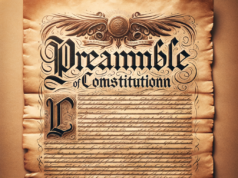Table of Contents
- 1 Understanding the Foundations: The Constitutional Framework of the United States
- 2 Historical Context: Key Events Leading to America’s Current Constitutional Crisis
- 3 The Role of Political Polarization in Eroding Constitutional Norms
- 4 Judicial Interpretation: How Courts Shape and Challenge Constitutional Principles
- 5 Public Perception: The Impact of Media and Misinformation on Constitutional Integrity
- 6 Path Forward: Strategies for Addressing and Resolving the Constitutional Crisis

As the United States grapples with a series of unprecedented political and social challenges, many experts are warning that the nation is facing a constitutional crisis. This term, often used to describe a situation where the fundamental principles of governance are under threat, has gained traction in recent years as political polarization, judicial interpretations, and misinformation have all contributed to a growing sense of instability. This article seeks to unravel the threads of America’s constitutional crisis by examining its foundational principles, historical context, and the various forces at play that threaten the integrity of the Constitution.
Understanding the Foundations: The Constitutional Framework of the United States
The United States Constitution, ratified in 1788, is the supreme law of the land, establishing the framework for the federal government and delineating the rights of citizens. It is built upon the principles of democracy, separation of powers, and checks and balances, designed to prevent any one branch of government from becoming too powerful. The Constitution not only outlines the structure of government but also enshrines fundamental rights through the Bill of Rights, ensuring that individual liberties are protected against government overreach. However, the very nature of the Constitution—its adaptability and the ambiguity of its language—has allowed for varied interpretations, which can lead to conflict and contention in times of political strife.
Historical Context: Key Events Leading to America’s Current Constitutional Crisis
To understand the current constitutional crisis, one must consider the historical events that have shaped American governance. The Civil War, the Civil Rights Movement, and the Watergate scandal are just a few examples of moments when the integrity of the Constitution was tested. More recently, the contentious elections of 2000 and 2016, coupled with the January 6, 2021, insurrection, have highlighted deep divisions within American society. Each of these events has contributed to a growing distrust in governmental institutions and a belief among many citizens that the Constitution is being undermined. As political leaders increasingly resort to extreme rhetoric and actions, the foundational principles of democracy are being called into question, leading to a crisis of legitimacy.
The Role of Political Polarization in Eroding Constitutional Norms
Political polarization has reached unprecedented levels in the United States, with citizens increasingly identifying with their political parties over a shared national identity. This division has eroded long-standing constitutional norms, such as bipartisanship and mutual respect among lawmakers. As political parties become more ideologically homogeneous, the willingness to compromise diminishes, leading to gridlock and dysfunction in governance. Furthermore, the rise of populism has encouraged leaders to bypass traditional constitutional processes, undermining the rule of law. This polarization not only affects the legislative process but also influences public opinion, creating an environment where constitutional principles are often viewed through a partisan lens rather than as universal standards to uphold.
Judicial Interpretation: How Courts Shape and Challenge Constitutional Principles
The judiciary plays a crucial role in interpreting the Constitution and shaping its application in contemporary society. Landmark Supreme Court cases, such as Brown v. Board of Education and Roe v. Wade, have set significant precedents that reflect evolving societal values. However, the politicization of the judiciary has raised concerns about the impartiality of judicial interpretations. The appointment of justices has become a contentious political issue, with each party seeking to influence the court’s ideological balance. This has led to a perception that judicial decisions are driven more by political agendas than by constitutional principles. As a result, the legitimacy of the courts is increasingly questioned, further complicating the nation’s constitutional crisis.
Public Perception: The Impact of Media and Misinformation on Constitutional Integrity
In the digital age, the media landscape has transformed dramatically, with social media platforms allowing for the rapid dissemination of information—and misinformation. The prevalence of “fake news” and partisan reporting has contributed to a fractured public perception of constitutional issues. Many citizens now rely on echo chambers that reinforce their beliefs while dismissing opposing viewpoints, leading to a distorted understanding of the Constitution and its principles. This environment fosters distrust in legitimate news sources and governmental institutions, exacerbating the constitutional crisis. As misinformation spreads, the public’s ability to engage in informed discourse about constitutional matters diminishes, threatening the very fabric of democracy.
Path Forward: Strategies for Addressing and Resolving the Constitutional Crisis
Addressing America’s constitutional crisis requires a multifaceted approach that emphasizes education, dialogue, and reform. Civic education must be prioritized to ensure that citizens understand their rights and the importance of the Constitution. Encouraging bipartisan dialogue among lawmakers can help restore trust in the legislative process and promote cooperation. Additionally, reforms aimed at reducing the influence of money in politics and enhancing transparency in government can help rebuild public confidence. Finally, combating misinformation through media literacy initiatives can empower citizens to critically evaluate information sources. By fostering a culture of respect for constitutional principles and encouraging active participation in democracy, the nation can begin to heal the divisions that threaten its foundational framework.
As the United States navigates this complex constitutional crisis, it is imperative that citizens, lawmakers, and institutions work collaboratively to uphold the principles enshrined in the Constitution. By understanding the historical context, recognizing the forces at play, and implementing strategic reforms, America can emerge from this crisis stronger and more united. The future of the nation’s democracy hinges on its ability to reaffirm its commitment to the rule of law and the fundamental rights that define its identity.

























